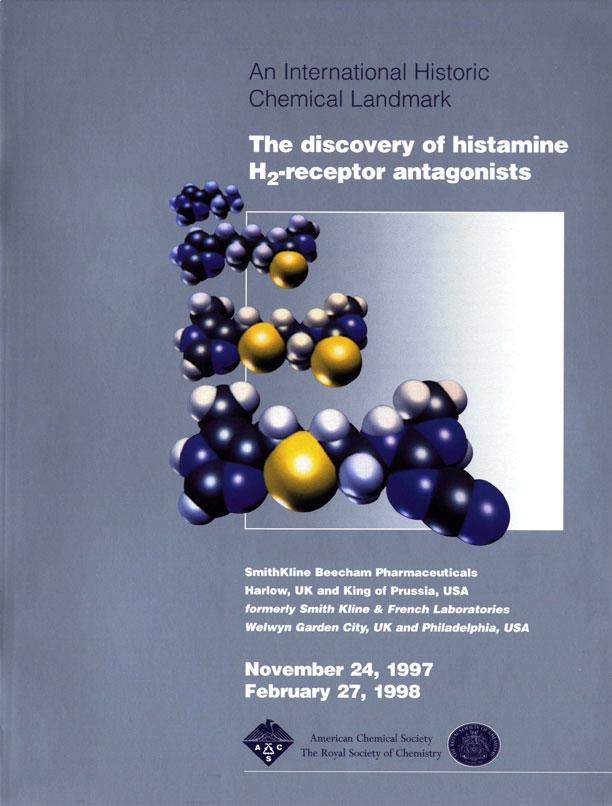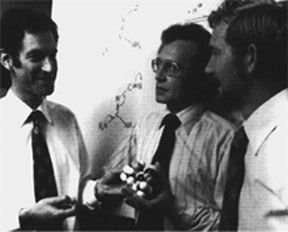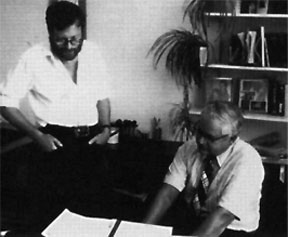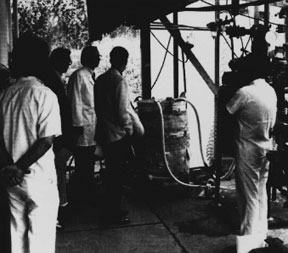Tagamet: The Discovery of Histamine H2-receptor Antagonists
Dedicated November 24, 1997, in Harlow, UK, and February 27, 1998, in King of Prussia, Pennsylvania, USA, at Smith Kline & French’s research facilities (now GlaxoSmithKline).
It’s hard to believe that, just 20 years ago, a peptic ulcer could be a life-threatening condition. The discovery of the compound cimetidine (sold under the trademark Tagamet) by researchers at Smith Kline & French in 1970 had a revolutionary impact on the treatment of this common disorder.
Contents
Tagamet®: A Revolutionary Ulcer Treatment
As late as the 1970s, a peptic ulcer could be a life-threatening condition. Sufferers often endured periods of intense pain over many years, especially at mealtimes and at night, with social and economic repercussions for themselves and their families. Left untreated, an ulcer could result in severe bleeding and death.
A major cause of ulcers is the release of excess stomach acid, which leads to breaches in the lining of the intestinal tract. Continuing acid secretion prevents healing. The main treatment used to be the administration of alkalis, which provided only temporary relief. Patients were told to rest and follow a bland diet. Surgery to remove part of the stomach was a last resort.
The discovery of the compound cimetidine by researchers at the UK laboratories of Smith Kline & French in the 1970s, transformed the lives of millions of people. Sold under the trademark Tagamet®, it was the first effective anti-ulcer drug and had a revolutionary impact on treatment. Tagamet® profoundly decreases acid secretion, thus promoting healing and avoiding the need for surgery.
New Era of Logical Drug Design
The research program leading to cimetidine also represented a revolution in the way pharmaceuticals are developed. Traditionally, the development of a new drug would often depend on the fortuitous discovery of a plant or microbial extract that showed some of the required biological activity. Using that first extract as a lead, many similar compounds would be made and tested for pharmacological effectiveness. In many cases, the researchers did not know how the drug worked, so finding an optimal compound was difficult.
The development of cimetidine was radically different: It was one of the first drugs to be designed logically from first principles. Smith Kline & French's multidisciplinary research team first looked at the physiological cause of acid secretion. They confirmed that a molecule found in the body called histamine triggers the release of acid when it binds to a specific receptor (now called the H2-receptor) in the stomach lining. Their aim was to find a molecule that successfully competed with histamine in combining with the receptor, but then blocked, rather than stimulated, acid release. Such a molecule was called a histamine H2-receptor antagonist and represented a new class of drugs.
Using a step by step analysis of structural and physical properties, the team made a series of histamine-based molecules, which were then tested for antagonist activity using carefully designed pharmacological assays. Today, this approach of rational drug design underpins the discovery programs of many major pharmaceutical companies.
Discovery of Histamine H2-receptor Antagonists
The discovery of histamine H2-antagonists is a story of single-minded commitment by a group of creative scientists working in close collaboration in the United Kingdom. The process of research and development for economical production of the resulting drug, cimetidine, was the work of equally creative scientists working in the United States.
Discovery of H2-receptor Antagonists
In 1963 George Paget, a pathologist from ICI (Imperial Chemical Industries), joined Smith Kline & French to head its R&D laboratories at Welwyn Garden City in the United Kingdom. He soon recruited two colleagues: James Black as head of pharmacology and William Duncan as head of biochemistry.
Black had been instrumental in developing beta-blocker drugs for the treatment of heart disease. They were based on his notion of blocking the stimulating action of a molecule (agonist) at a receptor site implicated in the disease with a similar but inactive chemical (antagonist). He was keen to start a new research program looking at histamine receptors and antagonists.
Histamine is found throughout body tissues and is released during allergic reactions such as hay fever. It also stimulates acid secretion in the stomach and increases the heart rate. However, tests with antihistamines had indicated there were possibly two types of histamine (H) receptor, one of which did not respond to antihistamines. Black wanted to establish the existence of the latter receptor and to find histamine antagonists that selectively inhibited acid secretion. Since this work promised to lead to an effective anti-ulcer medicine, the company started an acid secretion program in 1964.
Chemists Graham Durant, Robin Ganellin, and John Emmett joined Black on the project together with Mike Parsons, a pharmacologist. Their aim was to make chemical variants of histamine and test them for antagonism using a combination of in vitro and in vivo assays.
A New Receptor
The histamine molecule has a ringlike structure with a short side chain attached. Black's first idea was to alter the ring by tacking on chemical groups. Although no antagonists were found, it did produce an agonist called 4-methylhistamine, which stimulated acid secretion without any of the other histamine responses. This proved the existence of a second receptor, thus establishing a clear target for drug research. The project was then renamed the H2-receptor program.
However, finding and synthesizing potential histamine antagonists turned out to be more difficult than expected. By 1968, of the 200-odd compounds made, none had shown any activity in the assays. Fortunately, Parsons recognized that modifying the assays would increase their sensitivity. The team then retested a compound Durant had made earlier and found that it showed partial antagonism.
Tagamet®: A Revolutionary Treatment
Durant's compound became the lead, and after two years of hard work, an active antagonist called burimamide was produced. Burimamide was not orally active and so a new analogue, metiamide, which was orally active and ten times more potent, replaced it. The results of clinical trials with metiamide begun in 1973 were impressive: ulcers were healed within three weeks. Unfortunately, metiamide gave rise to a blood disorder called agranulocytosis as a side effect of treatment. This had been anticipated as a possibility, so as an insurance policy, the team prepared a similar compound replacing the thiourea group with a cyanoguanidine moiety.
The new lead compound, cimetidine, passed every test with flying colors and in November 1976 was launched as Tagamet® (derived from the anTAGonist and ciMETidine). Tagamet® was greeted with great enthusiasm by doctors and patients alike. Ten years after its introduction, it had achieved sales of one billion dollars and had become the world's number one prescription drug.
Producing Tagamet®
With the spectacular success of Tagamet®, it became very important to discover an economic process to make cimetidine. The production volume was expected to reach 1,000 tons a year - a large amount by pharmaceutical standards.
Process Patent Protection for Tagamet®
The initial process used to prepare cimetidine, while adequate for initial supplies, involved a bottleneck step which required the reduction of an imidazole ester intermediate using lithium aluminum hydride (LAH). The LAH process was difficult and expensive to operate and was threatened by a shortage of LAH supplies. Because of the high dose of cimetidine, cost reductions were essential to make the revolutionary new drug successful in the market. Since cimetidine was anticipated to be a worldwide success, it also would require patent protection around the world, including countries that offered process patent protection only.
To address these issues, Charles Berkoff and Elvin Anderson established a process research effort at the Smith Kline & French research and development facilities in Philadelphia aimed at finding cost-effective, practical, and patentable routes for synthesizing cimetidine. Groups headed by George Wellman and Lee Webb were among the first in the industry to emphasize the search for new synthetic methods instead of optimization of existing processes.
The initial objective was to find alternative routes to an alcohol intermediate. A number of alternate methods of preparing the alcohol were devised and patented, and the most cost-effective method, using sodium in liquid ammonia for the reduction of the ester, was finally implemented. This cleaner, less expensive pathway helped cut tens of millions of dollars per year from the manufacturing cost. Many of the other innovative methods of preparing cimetidine also provided process patent protection and therefore enhanced exclusivity in countries around the globe. This process patent strategy was especially important in Japan, where it was not possible to protect the product any other way.
A Better Manufacturing Process
Manufacturing of cimetidine was begun at Cork, Ireland, where production increased from approximately 18 metric tons in 1976 to about 1,000 metric tons by 1982. This dramatic increase in production demand led to further streamlining and perfection of the process. Low-cost cysteamine equivalents were implemented, and the alcohol was eventually acquired from a company that had developed a new manufacturing method employing a hydroxymethylation reaction. The number of operational steps was reduced and the throughput was dramatically improved so that the hundreds of tons of drug substance could be manufactured economically and in an environmentally friendly manner.
Just as the discovery of cimetidine is a landmark in logical drug design, so the discovery and development of efficient synthetic routes to cimetidine is a landmark in process research and development.
Discovery and Development Team behind Tagamet®
United Kingdom Discovery Research
Sir James Black was born in Scotland in 1924. He studied medicine at the University of St Andrews. His work at Smith Kline & French on establishing the role of the histamine H2-receptor in acid secretion leading to the discovery of antagonists must be considered his most significant achievement. It followed on naturally from his pioneering research carried out at ICI on beta-adrenogenic antagonists, or beta-blockers. On leaving Smith Kline & French in 1973, he took up the chair of Pharmacology at University College London. Four years later, he moved to Wellcome as Director of Therapeutic Research. In 1984 he was named Professor of Analytical Pharmacology at Kings College London. He was awarded the Nobel Prize for Medicine in 1988.
C. Robin Ganellin, born in London 1934, read chemistry and took his Ph.D. at Queen Mary College London. Following postdoctoral research at MIT, he joined Smith Kline & French in 1960 as a medicinal chemist and eventually became Vice President of Research at Welwyn. In 1986 he was appointed to the Smith Kline & French chair of Medicinal Chemistry at University College London. He received numerous awards from learned societies for his work on histamine H2 antagonists.
Graham J. Durant was born in 1934 in Wales and obtained his first degree and Ph.D. in chemistry from the University of Birmingham. Following postdoctoral work at the State University of Iowa, he joined Smith Kline & French in 1959. At the time he had a particular interest in guanidine chemistry which proved to be invaluable in the development of cimetidine. He became Head of Medicinal Chemistry before moving to establish the Center for Drug Design and Development at the University of Toledo in 1987 where he became Distinguished Professor of Medicinal Chemistry. In 1992, he became Senior Director of Chemistry at Cambridge Neurosciences in Cambridge, Massachusetts.
William Duncan who was Director of Research gave his unwavering support through all the low periods and when closure of the research program seemed likely.
John C. Emmett joined Smith Kline & French in 1965 and immediately became part of the team working on the H2 antagonist problem. Following the successful work leading to cimetidine, he moved into the area of selective thyromimetics and later became Head of Medicinal Chemistry.
Michael Parsons provided the essential pharmacological support characterizing the new receptor and the antagonist activity of the compounds made.
United States Development Research
R. Lee Webb was born in Australia in 1944. He obtained his bachelor’s degree with honors from the University of Melbourne and a Ph.D. in organic chemistry from the Pennsylvania State University in 1969. After two years of post-doctoral work at Indiana University he joined Smith Kline & French Laboratories as a medicinal chemist in 1971. Following work on the anthelmintics oxibendazole and albendazole (Zentel) he teamed up with George Wellman to form the Process Chemistry group in 1975 for the work on Tagamet®.
George Wellman was born in Detroit in 1945. He entered Kalamazoo College in 1963 and received a B.A. in 1967. Staying in chemistry and in Kalamazoo, he continued his studies at Western Michigan University where he received a M.A. degree in 1969 and a Ph.D. in 1972. He was awarded an NIH postdoctoral fellowship and continued his postdoctoral research at the University of Michigan. He joined Smith Kline & French Laboratories in 1973 working in process chemistry at the Spring Garden laboratories in Philadelphia.
Charles E. Berkoff and Elvin L. Anderson initiated the work to identify more efficient manufacturing processes. Bing Lam, Wilford Mendelson, Joseph Lewis, and Cliff Labaw worked with Wellman and Webb and were key contributors to the search for efficient processes for manufacturing cimetidine.
Further Reading
- The discovery of histamine H2-receptor antagonists (Royal Society of Chemistry)
- Our History: 1976 (GlaxoSmithKline)
- James White Black (Chemical Heritage Foundation)
- Autobiography of Sir James W. Black (Nobelprize.org)
Landmark Designation and Acknowledgments
Landmark Designation
The American Chemical Society and the Royal Society of Chemistry dedicated the discovery of histamine H2-receptor antagonists, which led to the development of Tagamet®, as an International Historic Chemical Landmark on November 24, 1997, in Harlow, UK, and on February 27, 1998, in King of Prussia, Pennsylvania, U.S.A, at SmithKline Beecham’s research facilities (now GlaxoSmithKline). The plaques commemorating the events read:
Pioneering work by scientists in the laboratories of this company led to the first clinically effective inhibitor of gastric acid secretion. The worldwide introduction of cimetidine (Tagamet) revolutionized the treatment of peptic ulcers by dramatically reducing the need for surgical intervention. The work is recognized as the classic example of the systematic modification of a natural messenger substance (histamine) to create a therapeutically useful blocking agent. Effective commercialization of this discovery was greatly facilitated by the subsequent investigation and design of novel synthetic routes, which led to the development of an efficient chemical manufacturing process.
Acknowledgments
Adapted for the internet from “The discovery of histamine H2-receptor antagonists,” produced by SmithKline Beecham Pharmaceuticals, the Public Affairs Department of The Royal Society of Chemistry and the Office of Public Outreach of the American Chemical Society in 1998.
Learn more: About the Landmarks Program
Take action: Nominate a Landmark and Contact the NHCL Coordinator






